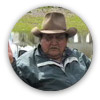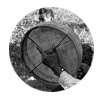Places | Madáts'atl'ǫje (Snare Hill)

Stories

Sam Acko, telling a Dane-zaa story of The Man Who Turned Into A Moose, 2005.
![]() Click to Watch
Click to Watch
Sam Acko talks about the importance of Madáts'atl'ǫje (Snare Hill) to Dane-zaa people in "survival times," when moose were scarce. He also tells a traditional Dane-zaa story about a man who transformed into a moose. Madáts'atl'ǫje (Snare Hill), 2005.

Tommy Attachie, talking about the impact of industrialization on Dane-zaa lands. July, 2005
![]() Click to Watch
Click to Watch
Tommy Attachie, sitting in front of an oil well in the Madáts'atl'ǫje (Snare Hill) area, talks about how the landscape has changed since he spent time here as a boy in 1958. He describes the impact that the forestry and oil and gas industries have had on the Dane-zaa landscape and Dane-zaa culture. The footage of oil wells and industrial damage to Dane-zaa lands was filmed by Stacy Shaak, Robin Ridington, and Kate Hennessy between 2001 and 2006. The piece was edited by Kate Hennessy and Malcolm Levy, 2006.
Songs

Billy Makadahay singing a song by the Dreamer Adíshtl'íshe, 1969.
Billy Makadahay sings a song by the Dreamer Adíshtl'íshe. Billy Makadahay settled at Petersen's Crossing in the early 1950s. This was recorded at the memorial Tea Dance for Anno Davis. Doig River, August 1969.

Charlie Dominic singing a song by the Dreamer Adíshtl'íshe, 1979.
Charlie Dominic sings a song by the Dreamer Adíshtl'íshe. Doig River, 1979. Tommy Attachie has explained (2006) that this is an important and powerful song for Dane-zaa. It is often used during cold times to bring warm weather.

Billy Makadahay singing a song by the Dreamer Adíshtl'íshe at the memorial for Anno Davis. Doig River, 1969.
Billy Makadahay singing a song by the Dreamer Adíshtl'íshe at the memorial for Anno Davis. Doig River, 1969. Tommy Attachie has explained (2006) that this is an important and powerful song for Dane-zaa. It is often used during cold times to bring warm weather. In this case it was used during a memorial to assist the deceased's (Anno Davis's) journey along the trail to Heaven.
Snare Hill Photos:
Slide show not displaying? Click here to view images
This place is called Madáts'atl'ǫje, which means "Snares Set Around It." We have been hunting and trapping here for as long as we can remember. We used to rely on Madáts'atl'ǫje during the long cold winter when food was scarce, because our hunters could always find moose here to sustain us. We would set up large snares around the hill at the center of Madáts'atl'ǫje, and then drive the moose off the hill and into our snares.
You can watch Sam Acko talk about hunting, survival, and respect for animals in the story of "The Man Who Turned in a Moose" at Madáts'atl'ǫje. Then, listen to the late Billy Makadahay singing the "Hard Times" song, which was often sung during times of extreme cold and hardship, to bring warmer weather.
Over the last fifty years, the area around Madáts'atl'ǫje has been greatly impacted by oil and gas development. Now, pipelines radiate out from the Ladyfern Compressor Plant in all directions. The pipelines connect well sites and convey the oil and gas pumped out of this land to far away markets.
We are concerned that the moose that eat the willows and drink the waters near the well sites will become sick from the chemicals used in oil and gas production. That is why we monitor the developments in this area and exercise our Aboriginal and Treaty rights to protect our natural resources.
Tommy Attachie talks about what Snare Hill was like before industrialization, how industrialization has affected Dane-zaa people, and what he hopes for the future.


